

How three conspiracy theorists took 'Q' and sparked Qanon. In November 2017, a small-time YouTube video creator and two moderators of the 4chan website, one of the most extreme message boards on the internet, banded together and plucked out of obscurity an anonymous and cryptic post from the many conspiracy theories that populated the website's message board. Over the next several months, they would create videos, a Reddit community, a business and an entire mythology based off the 4chan posts of “Q,” the pseudonym of a person claiming to be a high-ranking military officer. The theory they espoused would become Qanon, and it would eventually make its way from those message boards to national media stories and the rallies of President Donald Trump.
Now, the people behind that effort are at the center of a fractious debate among conspiracy enthusiasts, some of whom believe the three people who first popularized the Qanon theory are promoting it in order to make a living. Part of the Qanon appeal lies in its game-like quality. The anons. What are deepfakes – and how can you spot them? What is a deepfake?
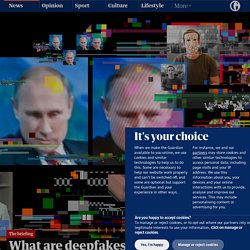
Have you seen Barack Obama call Donald Trump a “complete dipshit”, or Mark Zuckerberg brag about having “total control of billions of people’s stolen data”, or witnessed Jon Snow’s moving apology for the dismal ending to Game of Thrones? Answer yes and you’ve seen a deepfake. The 21st century’s answer to Photoshopping, deepfakes use a form of artificial intelligence called deep learning to make images of fake events, hence the name deepfake.
Want to put new words in a politician’s mouth, star in your favourite movie, or dance like a pro? Why some baby boomers are eating up the QAnon conspiracy. 9 charts comparing Trump economy to Obama, Bush administrations - Business Insider. NewsFeed Defenders. Our new media literacy game teaches players how to detect and disregard disinformation and misinformation in today’s chaotic environment.
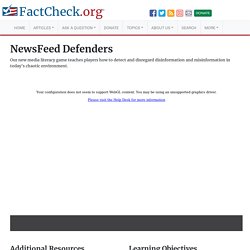
Learning Objectives Identify markers of verification, transparency, accountability, and independence in news stories.Define and identify problematic news items, and other news-related types of misinformation.Explain a variety of strategies to verify images and information.Evaluate text for bias based on word choices and framing methods.Use third-party information to judge the credibility of a source.Evaluate the benefits and challenges of digital news and social media to a democratic society.
Teacher Extension Pack Make your students’ gameplay more meaningful by using our activity and assessment set designed specifically for NewsFeed Defender. This easy-to-use Extension Pack helps you give context and purpose to the game, as well as reinforce and assess the game concepts. Download the Teacher Extension Pack. There is no middle ground for deep disagreements about facts. Consider how one should respond to a simple case of disagreement.
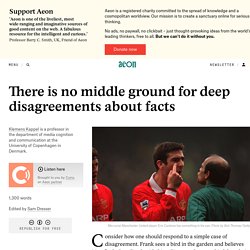
Frank sees a bird in the garden and believes it’s a finch. Standing beside him, Gita sees the same bird, but she’s confident it’s a sparrow. Fact Check. Michael Patrick Lynch: How to see past your own perspective and find truth. 10 Ways to Spot a Fake News Article - EasyBib Blog. For many of us, 2016 is going down as a year to forget.

Election upsets, Zika, the Syrian crisis, and unfortunately tons of fake news about all of the above and everything in between. Denzel Washington was recently quoted as saying, “If you don’t read the newspaper, you’re uninformed. If you do read the newspaper, you’re misinformed.” Did a Black Woman Named Malinda Borden Perish Because Titanic's Lifeboats Were 'Whites Only?' A photograph purportedly showing a woman named “Malinda Borden” is frequently shared on social media along with the claim that she had worked aboard the RMS Titanic and drowned at sea when that ship sank on its maiden voyage, as lifeboat seats were only made available to white passengers.
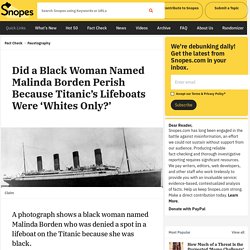
Her name, according to the viral Facebook post, was nearly lost to history because the black workers who perished during the disaster were listed as property that was lost, rather than being included in the list of victims: Don't be fooled by fake images and videos online. One month before the 2016 U.S. presidential election, an “Access Hollywood” recording of Donald Trump was released in which he was heard lewdly talking about women.
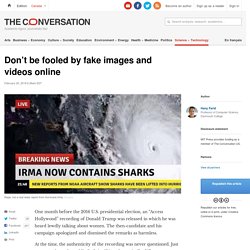
The then-candidate and his campaign apologized and dismissed the remarks as harmless. At the time, the authenticity of the recording was never questioned. Just two years later, the public finds itself in a dramatically different landscape in terms of believing what it sees and hears. News Feed – Updated 6/22/17 – Center for News Literacy. Poynter: Knight Foundation awards $1 million to projects aimed at fighting misinformation (June 22, 2017) Education Week: Media/News Literacy Training Goes a Long Way for Teachers (video) (June 21, 2017)DallasNews.com: Small Texas paper's name co-opted by Ukrainian site to peddle fake news (May 27, 2017)NorthJersey.com: Teaching news literacy in the age of fake news (May 19, 2017) Voice of America: Schools, Universities Teach Students the Truth About Fake News (April 5, 2017) The Guardian: New fake news dilemma: sites publish real scoops amid mess of false reports (May 16, 2017)WOSU Public Media: Fake News Discussion on All Sides with Ann Fisher (April 18, 2017) The Washington Post: Colleges turn 'fake news' epidemic into a teachable moment (April 6, 2017)New York Times: In an Era of Fake News, Teaching Students to Parse Fact From Fiction (March 20, 2016) Vice: Can Librarians Save Us from Fake News?

Moyers and Company Making Sense of the News Series - Written by CNL's Michael Spikes. News Literacy VOA - Voice of America English News. Media Bias Chart, 3.1 Minor Updates Based on Constructive Feedback - ad fontes media. So why is it time for another update to the Media Bias Chart?

I’m a strong believer in changing one’s mind based on new information. That’s how we learn anyway, and I wish people would do it more often. I think it would lead to nicer online discussions and less polarization in our politics. Perhaps people don’t “change their minds based on new information” as much as they should because it is often framed more negatively as “admitting you are wrong.” I don’t particularly mind admitting I’m wrong. In any event, I’m making some minor updates to the Media Bias Chart, corrections, and improvements based on feedback I’ve gotten. The Media Bias Chart Updates Here are the changes for version 3.1. The 12 cognitive biases that prevent you from being rational. The human brain is capable of 1016 processes per second, which makes it far more powerful than any computer currently in existence.

But that doesn't mean our brains don't have major limitations. The lowly calculator can do math thousands of times better than we can, and our memories are often less than useless — plus, we're subject to cognitive biases, those annoying glitches in our thinking that cause us to make questionable decisions and reach erroneous conclusions. Here are a dozen of the most common and pernicious cognitive biases that you need to know about. Before we start, it's important to distinguish between cognitive biases and logical fallacies. A logical fallacy is an error in logical argumentation (e.g. ad hominem attacks, slippery slopes, circular arguments, appeal to force, etc.). Some social psychologists believe our cognitive biases help us process information more efficiently, especially in dangerous situations.
Meet the man who makes fake news for millions of conservative Trump supporters. The only light in the house came from the glow of three computer monitors, and Christopher Blair, 46, sat down at a keyboard and started to type.

His wife had left for work and his children were on their way to school, but waiting online was his other community, an unreality where nothing was exactly as it seemed. He logged onto his website and began to invent his first news story of the day. "BREAKING," he wrote, pecking out each letter with his index fingers as he considered the possibilities. Maybe he would announce Hillary Clinton had died during a secret overseas mission to smuggle more refugees into America. Maybe he would award President Donald Trump the Nobel Peace Prize for his courage in denying climate change. A new message popped onto Blair's screen from a friend who helped with his website.
Join Independent Minds For exclusive articles, events and an advertising-free read for just £5.99 €6.99 $9.99 a month Get the best of The Independent "Good morning, Shirley! Vaccines: An Unhealthy Skepticism. Is NASA Planning to Geoengineer Yellowstone’s Supervolcano Threat Away? Despite repeatedly claiming that the Yellowstone caldera does not pose a super-eruption risk in our lifetimes, NASA has admitted the threat is real and is working to geoengineer a solution to negate that risk. In the realm of of science-based clickbait, no topic is more reliable for delivering page views and social media shares than claims that the pool of magma sitting below Yellowstone National Park is about to erupt in a humanity-ending cataclysm.
As we have repeatedly, exhaustingly, and redundantly reported, the likelihood of that mega-disaster’s occurring in the next couple of thousand years is extremely low, and the region is monitored continuously for threatening activity which would provide ample warning if that situation were to change for some currently unknown reason. A perfect example of the pervasiveness of this claim (and, perhaps, the futility of fact-checking it), comes from the apocalypse-oriented website Breaking Israel News. Developing Questions for Critical Thinking. People who think their opinions are superior to others are most prone to overestimating their relevant knowledge and ignoring chances to learn more.
By guest blogger Tom Stafford We all know someone who is convinced their opinion is better than everyone else’s on a topic – perhaps, even, that it is the only correct opinion to have. Maybe, on some topics, you are that person. No psychologist would be surprised that people who are convinced their beliefs are superior think they are better informed than others, but this fact leads to a follow on question: are people actually better informed on the topics for which they are convinced their opinion is superior? This is what Michael Hall and Kaitlin Raimi set out to check in a series of experiments in the Journal of Experimental Social Psychology. The researchers distinguish “belief superiority” from “belief confidence” (thinking your opinion is correct).
As well as simple background knowledge, the researchers were also interested in how people with belief superiority sought out new information relevant to that belief. Overall the research presents a mixed picture. Truth, truthiness, triangulation: A news literacy toolkit for a “post-truth” world. We were guaranteed a free press, We were not guaranteed a neutral or a true press. We can celebrate the journalistic freedom to publish without interference from the state.
Information Power. The mission of the library media program is to ensure that students and staff are effective users of ideas and information. This mission is accomplished: by providing intellectual and physical access to materials in all formats by providing instruction to foster competence and stimulate interest in reading, viewing, and using information and ideas by working with other educators to design learning strategies to meet the needs of individual students. --Information Power: Guidelines for School Library Media Programs (1988), p.1 The mission statement for Information Power: Guidelines for School Library Media Programs is as relevant today is it was in 1988, and so it remains the mission statement for the information literacy standards for student learning as well and for Information Power: Building Partnerships for Learning.
Excerpted from Chapter 1, "The Vision," of Information Power: Building Partnerships for Learning. Embedded References. Sorting the Real Sandy Photos From the Fakes. With Hurricane Sandy approaching the New York metro area, the nation's eyes are turning to its largest city. Fact-checking an immigration meme that's been circulating for more than a decade.
A viral image on social media -- one that’s critical of illegal immigration -- has been circulating for years. The list of claims first circulated in the form of a chain email in 2006, according to Snopes.com. The Problem with Fake News (and how our students can solve it) Our brains rapidly and automatically process opinions we agree with as if they are facts.
By Christian Jarrett In a post-truth world of alternative facts, there is understandable interest in the psychology behind why people are generally so wedded to their opinions and why it is so difficult to change minds. We already know a lot about the deliberate mental processes that people engage in to protect their world view, from seeking out confirmatory evidence (the “confirmation bias“) to questioning the methods used to marshal contradictory evidence (the scientific impotence excuse). Fake news 2.0: personalized, optimized, and even harder to stop. Fake news may have already influenced politics in the US, but it’s going to get a lot worse, warns an AI consultant to the CIA.
Fake News. False News Travels Farther, Faster Than The Truth, MIT Study Finds. Teaching Adolescents How to Evaluate the Quality of Online Information. An essential part of online research is the ability to critically evaluate information. This includes the ability to assess its level of accuracy, reliability, and bias. How biased is your news source? You probably won’t agree with this chart. "fake news" not new 2 clicks. The tricks propagandists use to beat science.
Back in the 1950s, health professionals became concerned that smoking was causing cancer. We're climate researchers and our work was turned into fake news. Google, democracy and the truth about internet search. False, Misleading, Clickbait-y, and Satirical “News” Sources. Here’s a handy cheat sheet of false and misleading “news” sites. Facts Don't Win Fights: Here’s How to Cut Through Confirmation Bias. How Do We Ready Kids for the Next Generation of Fake News? To think critically, you have to be both analytical and motivated. How did the news go ‘fake’? When the media went social. Learning To Spot Fake News: Start With A Gut Check : NPR Ed. Teaching Strategies to Detect Fake News.
UA Report Examines Fake News and How to Stop It. The more outrageous, the better: How clickbait ads make money for fake news sites. Facebook, Google Spread Misinformation About Las Vegas Shooting. What Went Wrong? : All Tech Considered. Why Facts Don't Convince People (and what you can do about it) Prolific fake news writer Paul Horner dead at 38. Veles, Macedonia one center producing fake news for $ ( 2 clicks)
How to outsmart fake news in your Facebook feed. The Honest Truth about Fake News … and How Not to Fall for It (with Lesson Plan) The Fate of Online Trust in the Next Decade. Truth, truthiness, triangulation: A news literacy toolkit for a “post-truth” world. COLLECTION: Media Literacy and Fake News. The Ongoing Battle Between Science Teachers And Fake News : NPR Ed. Ken Paxton makes unfounded claim that Barack Obama used DACA to 'unilaterally confer' citizenship. How fake news does real harm. How I Managed to Design the Most Successful Educational Computer Game of All Time. Texas Republican Party Calls For Abstinence Only Sex Ed, Corporal Punishment In Schools. Why do we think poor people are poor because of their own bad choices? You won't believe what I'm about to tell you 2 clicks.
Facts Don't Win Fights: Here’s How to Cut Through Confirmation Bias. Why Design Thinking In Schools Loses Power When It’s Reduced To A Checklist. 10 Team-Building Games That Promote Collaborative Critical Thinking. The Benefits of the Common Core. Higher Order Thinking/Questioning/Growth Mindset. Anti-intellectualism Is Killing America. The concept of different “learning styles” is one of the greatest neuroscience myths. THUNK - 86. Cognitive Biases & the Socratic Method. Critical Thinking. We Need to Teach Kids How to Be Skeptical of the Internet. Learning Myths And Realities From Brain Science : NPR Ed.
5 tips to improve your critical thinking - Samantha Agoos. Can You Tell Fake News From Real? Study Finds Students Have 'Dismaying' Inability. How to tell fake news from real news. TED-Ed - Recognizing Rhetoric. 5 Ways Teachers Are Fighting Fake News : NPR Ed. Fake news. It's complicated. - First Draft News.
Why Spatial Reasoning Is Crucial For Early Math Education.